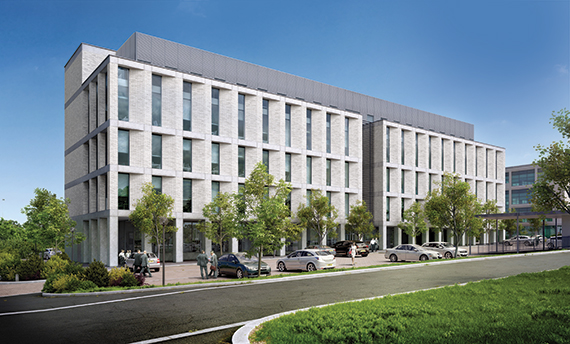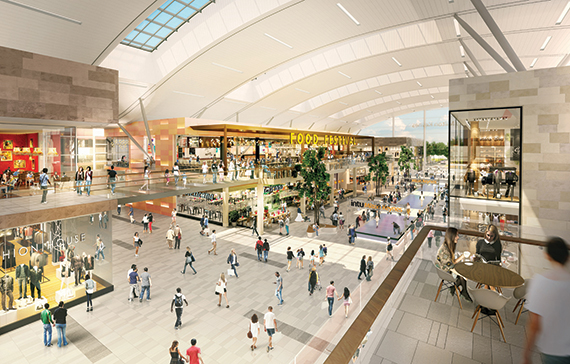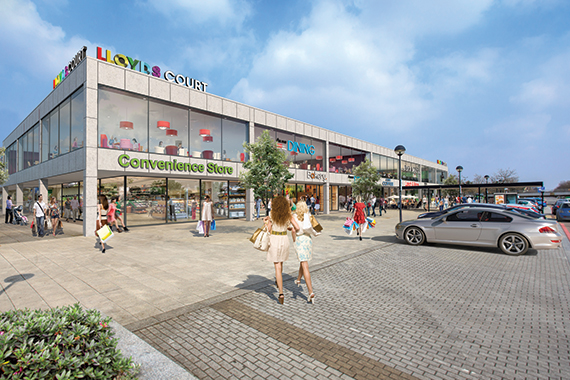 Milton Keynes is better known for concrete cows and roundabouts than economic prowess. Yet the much-maligned town is punching well above its weight.
Milton Keynes is better known for concrete cows and roundabouts than economic prowess. Yet the much-maligned town is punching well above its weight.
According to Irwin Michell’s latest UK Powerhouse report, Milton Keynes’s economy is growing faster than any UK city, including London.
The research, produced with the Centre for Economics and Business Research (CEBR), reported a 2.7% year-on-year rise in output, claiming its economy will grow 25% over the next 10 years.
Between 2004 and 2014, the town’s population grew by an incredible 18.1%, with Centre for Cities crowning it the fastest-growing city in the UK. The think tank also reported Milton Keynes’s GVA was more than 20% higher than the national average.
Being around 30 minutes away from London by train, Milton Keynes has already attracted big-name occupiers such as Network Rail, Santander, Home Retail Group and Red Bull Racing.
But can the town cope with further growth?
Space to grow
Designated as a new town in 1967, Milton Keynes was designed for a population of 250,000. Yet according to MKi Observatory, by 2026 it could be home to more than 300,000 people.
Alongside an impetus to accommodate new housing, there is pressure to unlock commercial development to keep pace with business growth.
Milton Keynes Council leader Peter Marland says: “There is significant space in the city centre still to be developed and we own around 90% of it. There are great opportunities for private developers to come on board.”
In 2013 the council established the Milton Keynes Development Partnership (MKDP) to promote the development of its land assets. It has a portfolio of more than 70 sites, comprising around 265 acres of developable land.
Frontier Estates is building Milton Keynes’s first major office development in eight years on one such site. Victoria House on Avebury Boulevard will provide 40,000 sq ft of grade-A space, half of which has been prelet to accountant Grant Thornton.
According to Bidwells, demand for office space in Milton Keynes is at its highest level since 2012. At the end of 2015 there were 945,000 sq ft of requirements for a market where annual take-up is typically around 350,000 sq ft.
Matt Willcock, director in the CBRE national office agency team, insists demand for Milton Keynes will continue to outstrip supply.
“Santander acquiring 70,000 sq ft at Columbia Threadneedle’s MK Central, as well as Catapult Transport Systems taking 35,000 sq ft at Aberdeen’s Pinnacle scheme, highlights the strength of Milton Keynes as an office location.”
Yet according to CBRE, the grade-A vacancy rate is now below 2%. There are proposals for new office development in planning, such as Barwood Capital’s scheme to provide 150,000 sq ft of offices at Woodlands Business Park, but occupiers have few options at present.
Luke Tillison, head of commercial agency at local agent Kirkby Diamond, says the lack of progress is frustrating. “MKDP is supposed to be building for the future, but so far very little has happened,” he says. “Occupiers and developers are turning to the likes of central Bedfordshire because the opportunities just aren’t there for them in Milton Keynes.”
Rent disparity
That lack of quality development has had a big impact on rents and the viability of new schemes.
“The underlying issue for Milton Keynes is that it trades at such a discount compared to other markets and that lack of rental growth is what is really holding it back,” says Knight Frank partner Ryan Dean.
Office rents languished at £20 per sq ft for years before Frontier’s prelet with Grant Thornton finally moved them on to £22.50 per sq ft. Yet there remains a gaping disparity between Milton Keynes and other locations such as Hemel Hempstead, at £26.50 per sq ft, Watford at £28.50 per sq ft and St Albans pushing £30 per sq ft.
Head of Bidwells’ Milton Keynes office Roger Yates says: “Rents have to be at around £24 per sq ft to be vaguely attractive for development appraisals and between £25 and £30 per sq ft for the quality of space MKDP is looking for.”
Yates says MKDP’s emphasis on quality is laudable if it produces results. He says: “They have not released land for mundane schemes and have come under criticism. Time will tell whether they are adopting the right strategy.”
MKDP chief executive Charles Macdonald admits more office space is needed, but insists: “We are progressing well, handling more than 30 transactions totalling over £30m of land value.”
He adds: “We are custodians of land for Milton Keynes. It would be a big advantage to get schemes out during this market cycle but they have to be appropriate and viable.”
Future MKDP projects include residential-led development at the 40-acre Campbell Park and the creation of a mixed-use district at the 20-acre B4 site close to Milton Keynes railway station.
In the meantime, MKDP has announced a development partner for strategic site B3.3N. Sterling Property Ventures has been chosen to develop a
1.5-acre site on Midsummer Boulevard.
Sterling intends to deliver a mixed-use scheme comprising 150,000-250,000 sq ft of offices, 150-250 PRS units and a skyline restaurant. It will include Milton Keynes’s tallest building, a 20-storey tower.
The developer concedes the scheme will need to achieve rents of £25 to £30 per sq ft to be viable, but is confident there is demand to fill it.
Sterling’s managing director, James Howarth, says: “If we build clever, brash and significant space, rental values will lift and impact on future development.”
Howarth believes the scheme, which will include an element of speculative development, will not only attract local occupiers looking to upgrade, but footloose corporates looking to relocate.
Howarth says he hopes to submit a planning application by the end of the year, and be on site in late 2017.
Knowledge is power
As well as targeting businesses looking to move at least part of their workforce out of London, Milton Keynes is keen to exploit its position in the Oxford-Milton Keynes-Cambridge knowledge corridor.
Council leader Marland says: “We have to ensure we don’t become Crewe, which was hugely important to the rail network, but didn’t make the most of its links.”
In terms of its own infrastructure, Milton Keynes’ infamous grid system is here to stay, but the future challenge will be how to create a more dense and diverse city centre which is as accessible by foot as it is by car.
Whatever the future holds, a strong development pipeline will be critical to Milton Keynes’s long-term success.
Kirkby Diamond’s Tillison concludes: “Milton Keynes has been held up as a beacon of growth, but we mustn’t rest on our laurels.”

Retail expansion hits the buffers
Developers are keen to boost Milton Keynes’s retail offer, yet it is proving a tough task.
Since intu purchased the 480,000 sq ft Midsummer Place shopping centre in 2013, it has attracted a number of upmarket fashion brands and boosted the city’s retail credentials.
Keen to build on its strengths, intu submitted a planning application to expand the centre by around 100,000 sq ft. The leisure-led extension will incorporate significant food and beverage provision, as well as four or five large retail units and a five-screen boutique cinema.
The council approved the development, only for it then to be called in by the Secretary of State.
Strong local opposition to the plans claimed it incorporated land identified as public open space in the CMK Business Neighbourhood Plan. An inquiry will be held in September with the inspector’s report due around the end of the year.
Intu’s director of development, Julie Pears, says: “It’s important that as Milton Keynes grows it invests in its infrastructure, and that includes retail and leisure provision.”
Kirkby Diamond’s Luke Tillison agrees ongoing investment is critical. “The city centre has seen a 6.2% drop in footfall since the opening of out-of-town scheme MK1. That is largely down to the fact that Primark has located there, rather than in central Milton Keynes.”
There were plans to develop a Primark store at thecentre:mk. However, it would have involved relocating the market, and in 2013 plans were abandoned in the face of local opposition.
The shopping centre is now having to find other ways of upping its offer. It plans to provide a 1,300-space car park and is spending £10m refurbishing Sunset Walk, a premium quarter which has recently attracted brands such as Joules and The White Company.
Centre director Kevin Duffy says: “We will have to wait and see what happens to the BHS store. If it leaves the centre it would be unfortunate, but could bring Primark back into the mix.”
In the meantime, the only significant retail investment cleared for delivery in central Milton Keynes is Palatium Investment Management’s Lloyds Court.
Planning permission has been granted to deliver 100,000 sq ft of new retail through the conversion of an office building at the junction between Silbury Boulevard and Secklow Gate.
The scheme, set to open in autumn 2017, will target the value market.
Whether other developers are able to negotiate local politics and get further retail development off the ground remains to be seen.
Andrew Simpson, planner and development manager at Dominic Lawson Bespoke Planning, says part of the problem is there is often tension between local campaigners wanting to retain Milton Keynes’s urban heritage and new development proposals.
He adds: “Milton Keynes will be 50 next year and it would be great if this is used as an opportunity to find better ways of moving forward.”












